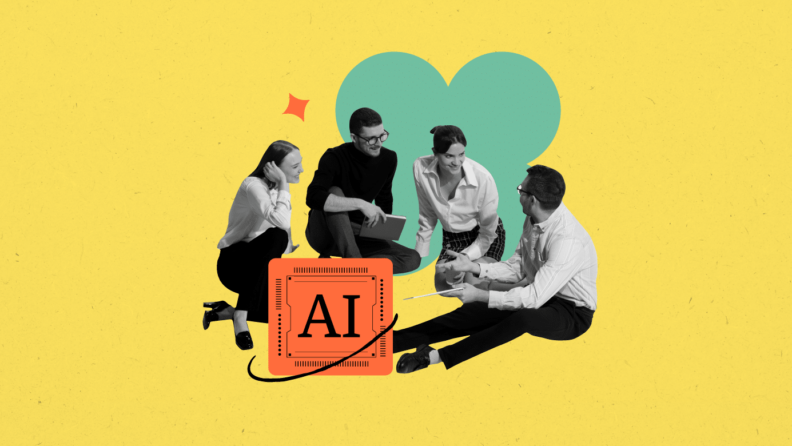Human collaboration and the ways we achieve it are constantly evolving, dating back to the earliest days of our history.
We started with cave paintings and telling stories around a fire. Over time, we added writing and travel, evolved with telegraph and television, and then expanded our reach and speed with the creation of the internet and our socially networked world.
Today, technology is not just altering, but evolving the essence of communication and revising our understanding of teamwork.
At the heart of this transformation lies a trinity of core values:
- Communication
- Creativity
- Empathy
These are being reimagined in the modern era due to the integration of Artificial Intelligence (AI) and robotics into the workplace.
AI has transcended its original data-centric role, now becoming an essential part of the workforce. It's no longer a tool for specific tasks or backend operations, but a comprehensive collaborator.
As this happens, it has the potential to change everything from team dynamics to process improvement to individual learning pathways and AI-powered recruitment system strategies.
In my book, “There is AI in Team,” I delve into the relationship between humans and AI entities in our lives and businesses. It's crucial for leaders and innovators, to recognize that AI is more than a facilitator or a passive tool, it's a vital team member, propelling efficiency, sparking innovation, and enhancing employee well-being.
A New Era of Teamwork
In recent months, virtual collaboration tools have integrated AI-driven bots that not only schedule meetings and manage tasks but also suggest workflow optimizations based on team interactions.
Features like real-time language translation and intelligent chatbots are breaking down the barriers in global, diverse teams, fostering a deeper understanding and smoother communication.
The potential for AI to impact decision-making is well documented. Before long, even the most important decisions will be made with assistance from AI-fueled technology.
A democratization of sorts will occur as this technology empowers teams with tools for analyzing complex datasets and offers insights through predictive analytics and trend analysis. These insights could enable quick strategic adjustments, ensuring that teams remain agile and responsive.
In project management, this has been a game-changer. When AI is given access to historical and current data for all aspects of the creative and product development process, it can evaluate ideas put forth by humans regardless of industry.
By automating routine tasks, like writing emails, reviewing reports, sending invoices, and other non-value-added tasks, humans will have to redirect their focus towards more intricate and creative endeavors.
Leaders in this new work environment must be aware of the change in work behavior. Measuring employee performance for task-based work is easily measurable and quantifiable. As human-performed tasks become more complex, quantifying and measuring them follows suit.
Managers will need to consider how these changes will impact their employees as some may not be as willing or able to take on these new responsibilities.
In the best cases, employees will rise to the occasion, acting as AI pioneers to push the boundaries of what the company can do with the technology. This means they may need training on how to effectively work with AI to generate the results they desire. It may also mean coaching them on how to be managers themselves with teams of AI agents to whom they can delegate tasks.
The ability to delegate will be new for many, and some may view this as a potential threat to their jobs. It will be important to help them see the short and long-term gains of incorporating these new skills and partners into their career goals so they can feel safe in the new workforce.
AI Recruitment
AI’s capabilities in the latest recruitment technology are already having a big impact on the way talent acquisition teams approach their work. Like with any capability AI takes on, there will be a period of adjustment.
Here are some things you can do right now to get off on the right foot with AI playing a bigger role in recruiting.
- Align your AI recruiting technology adoption with your organization’s values.
- Embrace both adaptation and adoption strategies to manage change effectively.
- Evaluate costs and benefits of implementing advanced AI in your teams.
- Identify skill gaps in your organization and assess the potential of transhuman and non-human team members.
- Implement collaborative robots, aka cobots, to automate repetitive tasks.
- Train employees how to include generative AI as functioning members of their teams and not just tools.
- Provide opportunities for employee upskilling and reskilling to adapt to technological advancements and changes in the workforce.
- Invest in developing soft skills such as creativity, leadership, and emotional intelligence, that AI cannot replicate.
In the realm of talent management, AI HR platforms can offer valuable insights into employee performance, equipping decision-makers with critical data for making informed choices regarding promotions and role changes. As career pathing shifts from the ladder model to more of a career lattice model, AI will play a part in skill identification and employee mobility.
Creative and Innovative Frontiers: AI as the Muse
In the days of Homer and the gods of the Greeks and Romans, there were nine goddesses of the arts and sciences called Muses. Sculptors, writers, alchemists, and creatives of all types had the benefit of their inspiration when they were in want of ideas.
Today, with the benefit of generative AI, we too have Muses in the form of GPTs of varying areas of focus. ChatGPT and HuggingFace have libraries of these Muses now at our disposal.
The design and development process has long been a stumbling block for companies of all sizes. For large companies, the cost of employing all of the skills required to accomplish each stage of production often means choosing time, quality, or cost as the driving force for their products - and usually only two of the three.
Incorporating generative AI in this process has changed that dynamic. At each stage, there is an opportunity for impacting all three.
| Traditional Product Design & Development Process | Collaborative Benefit with Generative AI |
| 1. Ideation & Conceptualization | Co-creative partnership: Human designers can collaboratively create diverse design options and inspirational content in minutes and often just seconds, enhancing the iterative process of human creativity and expanding the conceptual horizon. |
| Enhanced brainstorming: By applying AI tools as creative partners and production assistants, your team can generate a wealth of stimuli for new ideas and perspectives during brainstorming sessions. Your human team can discuss concepts, and generative AI can create first drafts, wireframes, storyboards, and proofs of concept. | |
| 2. Market Research | Data-rich insights: A single GPT can act as dozens of researchers combing through your internal documents and market data in a fraction of the time required for your human team. By allowing AI to aid humans in asking the right questions to decipher complex market data and reveal consumer trends and preferences through a conversational approach to in-depth analysis. |
| Emotionally attuned research: In addition, the speed at which AI can process free form response data is far beyond any human capability. AI's emotional analysis tools will continue to improve and add additional value to human intuition by providing quantitative insights into public sentiment. | |
| 3. Design & Prototyping | Iterative co-design: AI rapidly generates design variations, allowing designers to explore more options and refine concepts more effectively and efficiently. |
| Informed testing: AI simulates real-world conditions on prototypes. Your teams can leverage digital twins for observational focus groups, offering human designers critical insights for early product adjustments. | |
| 4. Development & Refinement | Intelligent enhancement: Your teams can use digital twins throughout the entire lifecycle of a product. By using real-time data from your company or synthetic data introduced by your team, AI can propose data-driven improvements. This can aid human developers in optimizing product features effectively. |
| Resource optimization: At each design and development decision point, humans can ask AI to suggest materials and look for process efficiencies. Humans can use this input to reduce costs and environmental footprint. | |
| 5. User Testing & Feedback Gathering | Predictive market insights: Your team can create virtual customer personas that can be used for focus groups in statistical quantities that allow AI to predict market reception at a scale not practical for human studies. Humans can augment strategic planning with data-driven foresight. |
| Integrated feedback analysis: Product teams can apply technology like the Internet of Things (IoT) to gather after purchase data on customer product usage. AI tools systematically analyze user feedback, and with generative AI, write ongoing use cases and tell the business stories associated with the data, enabling human teams to focus on roadmaps for future versions. | |
| 6. Production Planning & Launch | Strategic supply chain management: Human availability for strategic planning in production and distribution is often impacted by just getting the job done. Given the complexity of supply chain logistics and all of the associated levers impacting their management, having multiple AI agents continuously monitoring logistics and inventory can mean freeing up human time to work with all of the business functions to improve organizational effectiveness. |
| Market-aligned launch strategies: Today’s markets are extremely individualized. AI's predictive analytics and trend analysis can assist human marketers in crafting targeted, effective market entry strategies. This includes everything from design comps and narratives to the music and video used for advertising. Humans are the catalyst for the ideas and also the subjective review of media. |
You too, can benefit from this creative edge, even if only by improving the response time and quality of your emails.
Getting started is easy. Once you sign up for a GPT platform or creative tool, give these techniques a try:
- Foster interdisciplinary collaboration - address complex challenges in the human-non-human partnerships landscape. Look for ways to use AI as your assistant or co-pilot.
- Use more than one language model or framework - verify the sources cited by the LLMs, and if there is no citation, use a plagiarism checker. In the case of images, take the output of one image GPT and import and analyze it with another. In all cases, it is up to you to validate the content produced by the GPT much in the same way a journalist must confirm their sources.
- Assemble more than one GPT - AI has its own inherent biases stemming from the data the programmers used to train the models. By applying diversity and inclusion policies that consider the unique skill sets and backgrounds of all workers in your global talent pool - including AI - the output will be more representative of everyone. Even if you are a one-person shop, bring in others at key decision points to review the generative AI results to reduce bias and increase market opportunity.
- Take time to experiment - MidJourney, DALL-E, Crayon, MarketMuse are just a few of the 1000s of new tools coming out every day. To be competitive, you must stay informed about the latest trends in automation, AI, and other factors influencing the future of work.
Taking these steps is important as the time for employees to prepare for the next generation of prompt engineering - which will be less formatted and much more conversational - is now.
A symbiotic relationship between human creativity and AI's analytical capabilities is the crux of this new era of innovation. Teams can feed AI tools with their unique perspectives and professional objectives, enabling AI to customize its outputs by filling in contextual gaps.
Responsible AI Use
The ethical deployment of AI in the workplace is a subject of paramount importance, demanding careful attention to data privacy, the elimination of biases in AI decision-making, and the maintenance of transparency.
Governments, businesses, media institutions, and other agencies are rapidly trying to create policy and procedures for addressing the multitude of ethical issues emerging in the AI space.
Recent news on the impact of AI manipulations across social media, such as deep fake imagery of famous individuals like Taylor Swift and infamous politicians like Vladimir Putin, remind us daily that we must safeguard ourselves and our businesses in this new era.
If you are not already doing so, I recommend you:
- Follow the recommendations of the US White House Executive Order on Safe, Secure, and Trustworthy Artificial Intelligence and form AI ethics committees, conduct regular audits of AI systems, develop ethical AI policies, and engage in collaborative efforts.
- Develop a strategic plan for AI and robotics integration, considering benefits, risks, and workforce upskilling and reskilling.
- Establish training programs to equip employees with skills and knowledge for working effectively with AI and robotics.
- Foster a culture of learning, experimentation, and diversity in developing and deploying AI and robotics.
- Develop transparent and accountable policies and practices for AI and robotics use.
- Address ethical concerns, such as algorithmic bias and privacy issues, in AI and robotics.
- Provide awareness campaigns in the same way as you should address all areas of cybersecurity and intellectual property protection.
These measures aim to balance the exploitation of AI's potential with the challenges it poses, particularly in human resource functions where ethical implementation of AI is critical.
HR leaders will have to promote knowledge sharing, create internal communication channels, partner with AI vendors, consult external experts, and participate in industry events and forums to ensure they are prepared to address the risks of AI so we can in turn enjoy its benefits.
AI as the Harbinger of a New Work Ethos
The advent of AI in the workplace is leading to a redefinition of how teams collaborate, grow, and engage.
I envision the future of work as a seamless fusion of AI and human-centric goals. In this vision, AI does more than just support human efforts, it elevates the very essence of teamwork and employee training and development.
By embracing AI as a collaborative partner, organizations unlock unprecedented potential in productivity, creativity, and, ideally, employee satisfaction.
The key to harnessing the full potential of AI in the workplace lies in striking the right balance between technology and the human touch, ensuring that AI acts as a catalyst that not only drives business success but also fosters a more fulfilling and engaging work environment.
Want to learn more about how HR and people ops professionals? Subscribe to the People Managing People newsletter to receive insights on the latest developments in the world of HR directly in your inbox.





